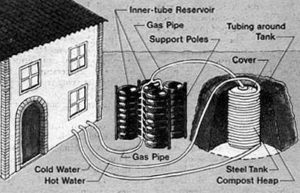Source: resilientfamily.com
Published: May 6, 2016

Jean Pain is a guy that you’ve probably never heard of… He was a French innovator and inventor who developed an innovative compost-based bioenergy system that produced 100% of all of his energy requirements. Essentially, Pain was able to distill enough methane for all of his cooking needs, power a generator for his electricity, and even provide fuel for his truck.
His unique method of creating usable energy from the decomposition of organic materials (composting) came to be known as the Jean Pain Method.
While Pain’s efforts were ambitious — it took more than 50 tons of compost to produce the 500 cubic meters of gas to keep him energy self-sufficient for more than a year — his compost hot water heating method was much more practical and judging by all of the YouTube videos, is increasingly popular.
The concept is simple: Decaying organic matter generates heat, and a lot of it. If you’ve ever stuck your arm deep into a big pile of wood chips or compost you’ll know exactly what I mean. Heat is generated, not as a result of sun exposure, but rather due to the chemical reactions and aerobic microbial activity taking place inside the compost pile itself.
While the construction specifics vary, most compost water heaters use about 100 feet of black polyethylene tubing coiled inside a compost pile in roughly four to five foot diameter loops. The coils are then connected to separate lengths of tubing, which carry water into and out of the interior of the compost pile. As outside water flows into the pile, it travels into the coiled tubing taking on heat as it goes.
So, how hot does the water get? If it’s done right, compost hot water heaters can generate inner temperatures of 130-150°F for 4 1/2 to 5 months before the compost pile breaks down and needs to be replaced with fresh compost.
The other great thing about composting water heaters from a resilience standpoint is that they serve a dual purpose. Once the compost no longer provides heat it serves a second purpose as a fertilizer and soil amendment that returns rich nutrients back into the soil.
This article no longer exists at the Source link above. It can be found in the Matteroftrust.org Resource Library.
